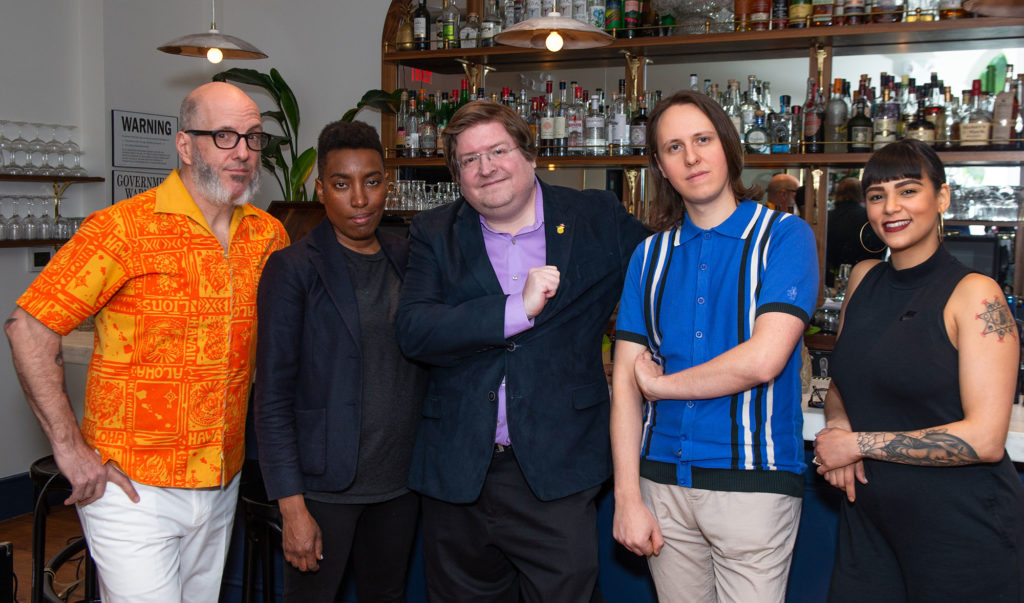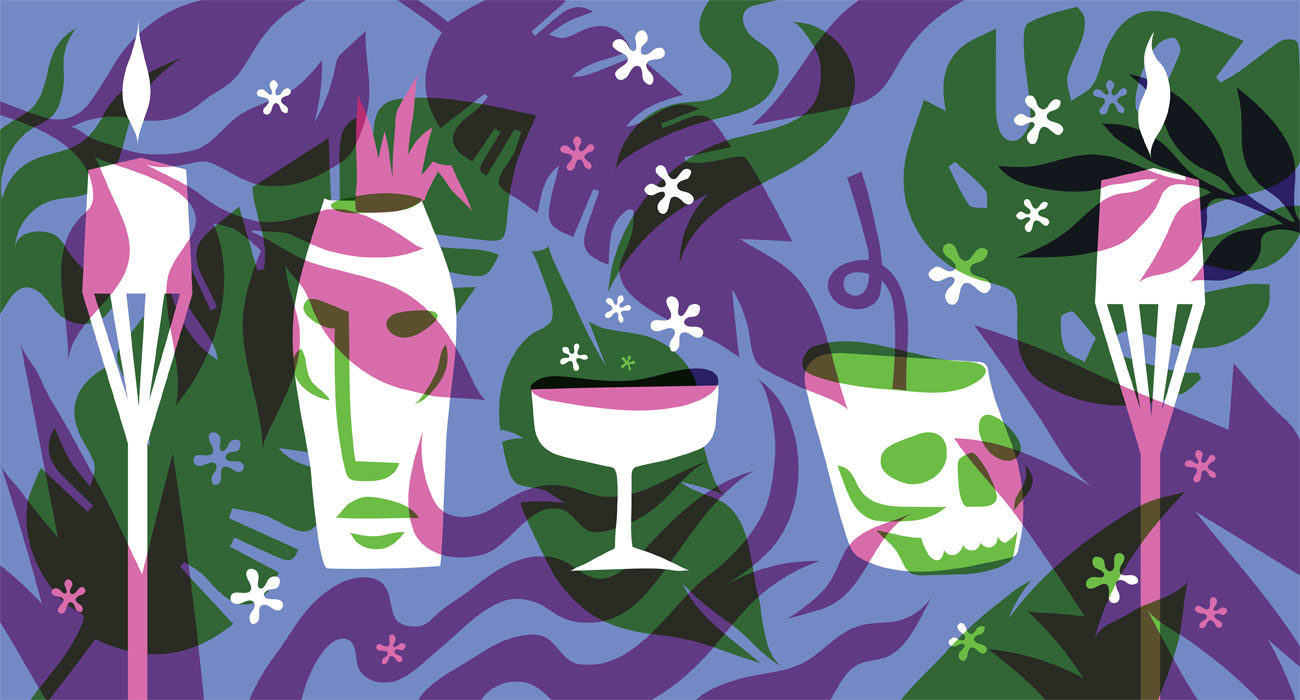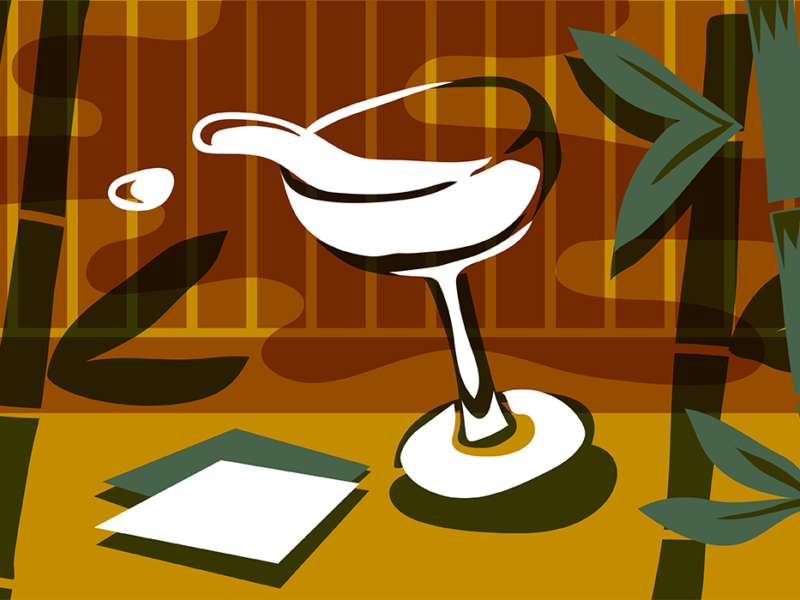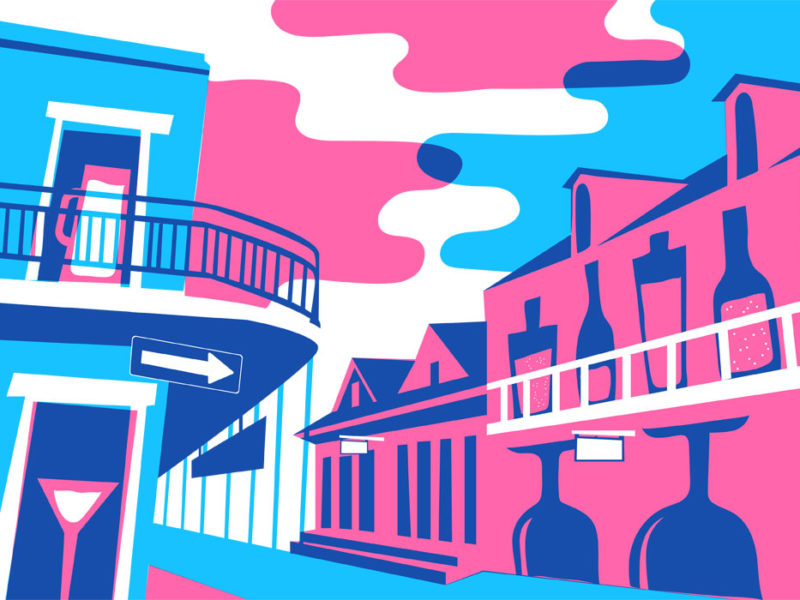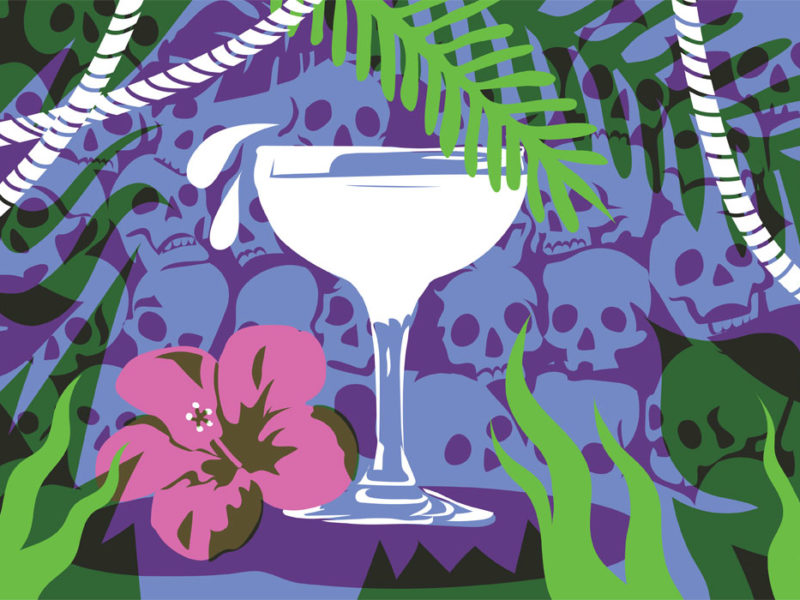Don’t worry, we’re not done with the Daiquiri. But there is another classic rum cocktail that merits a turn, that midcentury masterpiece—the Mai Tai.
(And we talked about Daiquiris a little, too.)
On March 11, 2020, we gathered a panel of experts at New York’s Jungle Bird for an evening of Mai Tai marvel. Then, on March 22, the state’s pandemic stay-at-home order came into effect. These events were not related, but it made this evening perhaps the Last Cocktail Soirée on Earth (For a While).
Meet the team:
Garret Richard left a career in radio to pursue his love of exotic cocktails. He worked under Julie Reiner at Monkey Bar in 2011 before moving to Prime Meats, where he built a following culminating in his Tiki Takeover series. In 2015, Garret joined the opening team of the Happiest Hour and Slowly Shirley, injecting his passion for tiki in both programs. Currently, he helms his pop-up, Exotica, at Raines Law Room. In 2018, Garret joined the opening team at Existing Conditions by Dave Arnold and Don Lee.
Shannon Mustipher is a veteran of the hospitality industry, having developed beverage concepts for a number of clients. Shannon’s writing, cocktail recipes, and opinions have been featured in media such as the Los Angeles Times, GQ, Bon Appétit, Imbibe, and Punch.com. In 2019, she was named one of SevenFifty.com’s Drinks Innovators and Imbibe’s 75 People to Watch.
For the past ten years, Natasha Bermudez has forged a path through New York City’s bar industry. After Death & Co. veteran Eryn Reece took Bermudez under her wing, and her talent for the craft began to flourish, Bermudez helped Reece open Banzarbar. Bermudez has since moved from bartender at Llama Inn, which has been featured in the Michelin Bib guide, to head bartender at three-star New York Times “Critics’ Pick” Llama San, where she created an original drink menu alongside beverage director Lynnette Marrero.
“Tiki” Adam Kolesar is the proprietor of Orgeat Works Ltd., purveyor of syrups to New York’s and the nation’s top cocktail bars. It all started with a 2002 enrollment in a Dale DeGroff hands-on seminar in midcentury rum punches. This former straight-edge punk rocker began his quest to create an orgeat with real ingredients, possessing a profile complementary to fine rums, to aid in the search for that elusive Mai Tai.
I wrote the script and directed it. My name is Ben Schaffer.
The discussion is presented in two parts, of which this is the first. Read Part 2 here.
Many drinks were expertly made that evening by Jungle Bird’s tip-top bartenders, Ali Brailey and Justin Ahdoot. Thanks must also go to Jungle Bird’s owner, Krissy Harris, and its events director, Marissa Cheshier, for making it all run smoothly.
Above all, this gathering would not have been possible without the critical mass of support from generous sponsors who came forward with the ingredients our bartenders requested: Appleton, Cointreau, Coruba, Denizen, Don Q, El Dorado, Pierre Ferrand, Giffard, Grand Marnier, Rhum J.M, Mount Gay, Orgeat Works, Plantation, Rum-Bar, Rum Fire, Skurnik Wines & Spirits, Wray and Nephew, and Zelda Magazine.
This transcript has been edited for length and clarity. — Ed.
Origins
Ben: To paraphrase Huckleberry Finn, “You don’t know about tiki without you have read a book by the name of Sippin’ Safari.” Or to paraphrase Ernest Hemingway, “All modern tiki literature comes from one book by Jeff Berry.”
It’s important to remember that while tropical drinks have long been a part of cocktail culture, many of their actual recipes were lost until Jeff Berry began his original research in the 1990s. This is not a discussion of that history per se, it’s about what this panel of creative bartenders is doing today. But the history is the foundation for that, and all bartenders owe a debt to that work. [Go read Sippin’ Safari; we’ll wait. —Ed.]
Here’s why we’re talking about Mai Tais tonight. This drink illustrates an important part of the contemporary craft cocktail revival, which is that you can’t always just make an old recipe out of a book. The ingredients are different today. The brands don’t exist, the formulas have changed. A contemporary bartender has to reinterpret, not just repeat. All the bartenders here tonight have come at the Mai Tai in different ways, each proposing a possible solution to the problem. For me, that’s an exciting thing about bartending. We’re going to talk about Mai Tai interpretations, over the course of six drinks.
What were each of your first encounters with tropical drinks? Garret, you come from Southern California, the epicenter of the tiki world then and now. When did you first come under its thrall?
Garret: I came at it from a weird angle. I was into the music first. I made films in high school—before YouTube, thank god, so there’s no evidence of it. And I had a friend who worked on the projects with us, his mother worked for Capitol Records. We happened to be doing a sequence that involved a lot of ’50s P.S.A. type things. He gave me the Ultra-Lounge compilation, and I fell in love with this weird instrumental lounge music, and that’s where it stayed for a while.
I bought Sven Kirsten’s book [The Book of Tiki, 2000], but the thing I was interested in was Exotica music, instrumental ’60s stuff that was never played. Then, in college, I lived with a lot of musicians. We would always trade stuff. I lived with somebody who’s a keyboard player and organist. I would download all of this kind of stuff, or buy it when Tower Records still existed, and trade with him. Here’s your rock organ stuff, here’s my cheesy cocktail music organ stuff. That’s the genesis of it. A lot of these records had cocktail references, like Tom Collins, the Highball. At the same time, I was teaching myself to cook because food in college cafeterias is horrible.
Ben: The cocktails are even worse.
Garret: I was in this D.I.Y. spirit already, and I saw Jeff Berry in the New York Times. I punched his name into eBay, and I got all four of his books in one snap. I had a roommate who had a band, and his keyboard player worked at Astor Wines. I told him I was interested in the books, but I couldn’t get the ingredients because I was twenty years old. He’d get me Appleton 12, and stuff like that, and we made random drinks out of Jeff’s books in my dorm. That’s how it started. And then when I could finally go out, that’s when Death & Co. was making the Winchester, and when Painkiller started, and Lani Kai. It was a good time to start.
Ben: Am I correct, Shannon, that your tiki journey began in the torrid climes of New York City?
Shannon: It really began with rum, and starting the Glady’s Caribbean project six years ago. I had worked in hospitality for four years prior, done some work in wine, but I was really blown away by the range of what rum could be. I had no idea that there was such a wide spectrum of flavors, that rum was made in a hundred countries around the world. I had an opportunity to really bring it home to people, and create a back bar, as well as a cocktail list, that would intrigue people and get them interested in what we were doing. The Mai Tai was the first cocktail that I came upon that I felt really challenged by. That was the first tiki or tropical cocktail I considered for that menu, which was, at the time, organized around 1920s Cuban classics. That was the deviation. I didn’t want to do tiki initially, but I trusted the Mai Tai and what it could convey around the quality of rum.
Ben: That’s interesting, since we understand that Vic himself was inspired by Cuban classics, and the fact that you like Cuban classics and Vic’s drink is a kind of proof of that connection.
Shannon: I needed to convince people that rum is worthwhile. And I saw the Mai Tai as a vehicle for that.
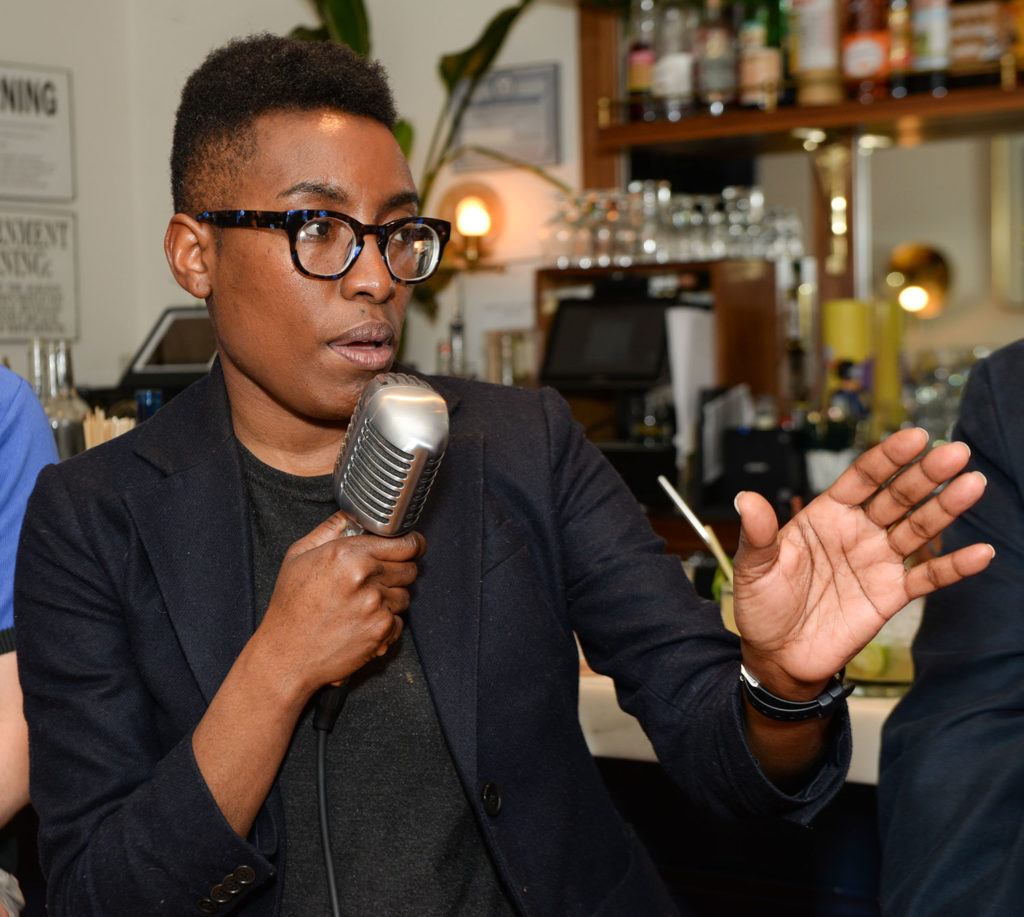
Ben: Natasha, as you were born in the Dominican Republic, you are the only Caribbean American member of the panel. But you also spent time in Fort Lauderdale sitting on a beach. What’s that all about?
Natasha: My first Mai Tai was on my twenty-first birthday. For the year and a half before I turned twenty-one, I worked at Da Big Kahuna, which was a place from the Big Island in Hawaii, and they opened one in Fort Lauderdale, next to Hooters. They’re no longer open. I was a hostess and a server, and back then it was all about Mai Tais, Blue Hawaiis, and a big punch on Hula Friday nights. But they didn’t call it tiki. I always say I worked at a Hawaiian restaurant. We put pineapples on our burgers, and we had dancers on Fridays, and fire, and all the good stuff. And you know what? I loved it. You could play video games if you were too drunk to actually talk to human beings. So, the tiki culture started for me then, without me realizing it.
Ben: But then you came here and worked with Eryn Reece and Lynnette Marrero, and Lynnette is one of the first tropical drink pioneers in recent New York bartending.
Natasha: Yes, Lynnette calls it tropical. She’s Puerto Rican, and I’m half Puerto Rican and half Dominican, so it’s the culture that we want to represent and we do not want to misrepresent. We bring that into our work, we bring a lot of Caribbean products, and we talk about them as proud Caribbean people. We don’t call it passionfruit, we call it chinola. We try to stick to our roots and always stay true to ourselves. After all, that’s what we’re all trying to do. Just like chefs do with food, we should bring the culture into drinks.
Ben: “Tiki” Adam, I read here on the program that you were teetotal for most of your life. Until none other than King Cocktail himself, Dale DeGroff, as he did for so many others, put you on the road to ruin.
Adam: I was a lifelong straight-edge punk rocker. I had met my adoring wife, and I had enough game to attract her. Our first date was at the Sidewalk Café in the East Village. We sit down and order a round of Rolling Rocks. We started drinking and talking. It’s going well enough that a second round is offered. “Would you like another?” “Yes, yes, we would.” Then my future wife says, “I’ll have another Rolling Rock.” What’s my response? “I’ll have water.”
“Does he really like me? What’s going on here?” She comes to find that my sum total of drinks was maybe four or five beers a year. We have a wonderful courtship, we managed to get married. But she is staring down the barrel of wine by the glass for the rest of her life. Something has to happen here. She knows I am into arcane midcentury traditions. We go to a flea market in Ohio and I find a tiki mug. That’s cool. We buy it. I have no idea what to put in it.
But then, as Ben mentioned, right as Dale DeGroff published his first book, he had a “Cocktail College” at the Marriott Marquis. And the subject was midcentury cocktails. We do a Zombie. We do a Hemingway Daiquiri. We do a Caipiruva. I don’t know how that got there, but it was there. And we do a Mai Tai.
This captures my imagination. Wow! These drinks are great. I’m interested in how to assemble them. But this is 2002, so now I’m assigned the task to collect all the components necessary to put these exotic drinks together. It set me on a journey to be able to create the drinks, by getting the Beachbum books, and pursuing what has become a lifelong passion to execute these drinks.
Ben: Back then you were just called “Adam.”
Adam: Right.
1944
Ben: Garret, catch us up on what the original 1944 Mai Tai spec would have been.
Garret: The Mai Tai is a lesson for bartenders and consumers alike about changing products. At its base, it has a rum that doesn’t exist anymore. Vic, in his constant battle of establishing that he created the Mai Tai, eventually had to let the recipe out. Which is against the behavior of most tiki owners and bartenders, who wanted to keep those recipes secret.
For him, originally, it used a seventeen-year-old Wray and Nephew Jamaican rum. Now, the only rum labeled Wray and Nephew now is a white overproof, and it’s very rare to get something pot-stilled, and aged in oak—which type, we don’t know. Possibly, back then, it could have been French Limousin.
Two ounces of seventeen-year-old Wray and Nephew Jamaican rum, about a quarter ounce of Garnier French orgeat, which was a very rich orgeat. It was at least a two-to-one, if not three-to-one, orgeat. Then a little bit of rock candy syrup, which is another rich simple syrup that Trader Vic used. It was about three parts sugar to one part water, a little bit of vanilla, and some salt. Then De Kuyper Holland Curaçao was the sweetener, in addition to the syrups.
Then the juice of one lime. Which is very, very, very vague, right? That’s something that plagued Beachbum Berry for years—how much is the juice of one lime? When you see the Trader Vic bartenders today, you actually get a better indication of what that is. If you get limes from the grocery store, the juice of one lime can be two ounces, while today at Trader Vic’s it tends to be about three quarters to one ounce, because of the type of hand juicer and the techniques that they’re using.
Then, you put all of those things together. This was not a drink that was flash-blended, although about eighty-five percent of the drinks in the tiki canon were flash-blended. This drink was slowly shaken with a fistful of crushed ice. The Trader Vic bartenders today tend to do this slow, rocking shake, and that’s just to get a little bit of chill, with most of the dilution coming from the crushed ice itself.
Then that was finished with the spent lime shell and a little bit of mint. That was the original recipe. And we’ll get into where the rum disappeared to, and how that changed over the years, and where the controversy is, and why you are going to taste so many different versions of the same drink.
1937
Ben: Along that line, before there was the Trader Vic Mai Tai that Garret just so evocatively described, there was a drink called the Q.B. Cooler, made by Don the Beachcomber in 1937. They have almost no ingredients in common, but Jeff Berry makes a compelling case that the Mai Tai was really Trader Vic’s attempt to reverse-engineer the Q.B. Cooler. And that’s actually the drink that you have now, the Q.B. Cooler, the recipe for which was offered by Adam. Would you like to talk a little bit about the Q.B.?
[Perhaps now is a good time to state that the Hollywood bar called Don the Beachcomber was opened by a guy named Ernest Raymond Beaumont Gantt, who for branding reasons later changed his name to Donn Beach. Why the bar was Don and the guy was Donn is a mystery for the ages. But Donn Beach is also often called Don the Beachcomber. This confusing conflation continues below, and forever. — Ed.]
Adam: You have history in a glass. The Q.B. Cooler—Q.B. standing for the Quiet Birdmen, an elite flying group in World War I. These guys still exist, they have a super-secret society. Donn Beach had a laudable record of military service, and wanted to devote a drink to this. This is an eleven-ingredient cocktail, and as Ben mentioned, Jeff did the primary research, digging deep into the controversy of who did indeed invent the Mai Tai. This was an ongoing battle throughout Trader Vic and Donn Beach’s lives.
Jeff was able to ascertain that, in 1937, the Q.B. Cooler was on that early menu, among the very early drinks of Donn Beach. Legend has it that while Trader Vic was running his barbecue joint up in Oakland, called Hinky Dink’s, he took a visit down to L.A., sought out and sat down at Donn Beach’s bar, and had this Q.B. Cooler. It’s a compelling drink, in that you can really taste the D.N.A. of what we know now as the Mai Tai. We’re looking at orange juice, ginger syrup, honey syrup, soda, in addition to a blend of rums. It’s very interesting how Donn Beach, and later Trader Vic, were able to create drinks that were very similar. And from the Q.B. Cooler, the Mai Tai just took off from there.
Ben: You didn’t mention one important ingredient, which is falernum. Falernum is a Barbadian liqueur or syrup with clove, lime, and a little bit of almond, but not always very prominent. So, how did Vic get from falernum to orgeat? Is it just he couldn’t tell what he was tasting in the Q.B. Cooler?
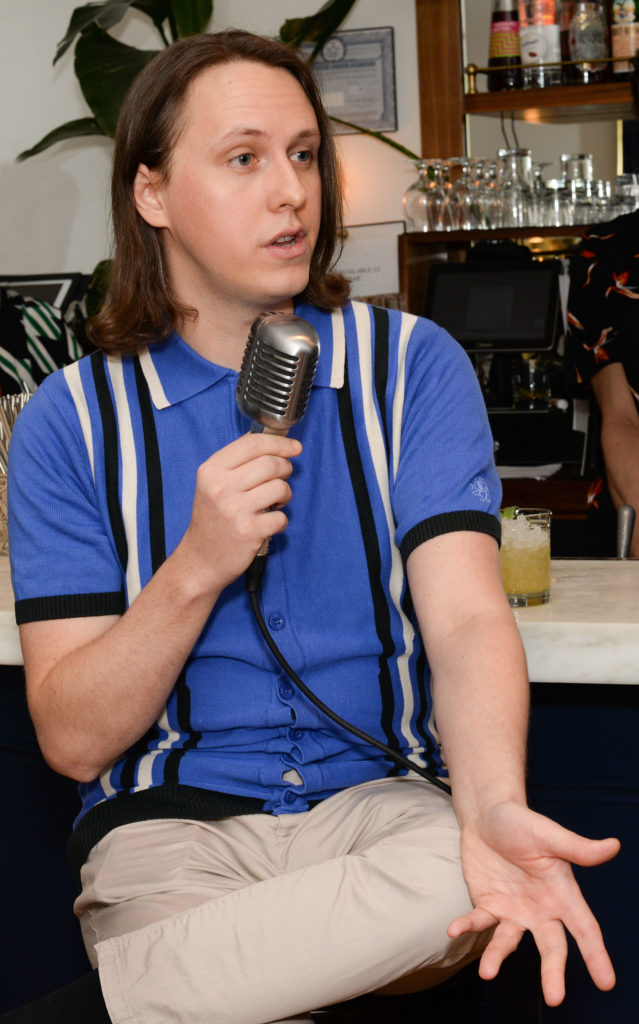
Garret: Just to wrap this part up in a little bow, Trader Vic obviously liked what Don the Beachcomber was doing, but Donn did not want to work with him. He offered to build a franchise of his establishment in Hollywood in every city. Donn said, “You’re just a rope-hanger, get out of here.” Trader Vic had to learn tropical bartending, and he wasn’t going to learn from Donn, so he went to Cuba, and he studied the bar that everyone knows from the Hemingway Daiquiri, Constantino Ribalaigua’s El Floridita. He sat there every night for a week, watched them work, watched the Cuban cantinero style.
Vic really liked the Q.B. Cooler. He wanted to make that drink, but he saw it through the lens of Cuban bartending. They were open about what their recipes were, they were open about their style. And he ran it through the lens of the El Floridita Daiquiri No. 2, which is similar to what a Mai Tai is. It’s rum, orange juice, lime, and Curaçao. The biggest difference between his Mai Tai and the Daiquiri No. 2 is that the orange is now orange liqueur, and instead of light Cuban rum, it’s very heavy Jamaican.
When you’re trying to emulate a cocktail, there can be lots of things going on in the back of your head. It’s an easy story to say, “Oh, well, they were just trying to copy this drink.” If I’m trying to recreate something from the Tiki-Ti, something very secretive, I’m usually thinking about three or four other cocktails in my head at the same time.
A Welcome Drink by “Tiki” Adam Kolesar
Adam: Just one point of clarification. The spec on the Q.B. Cooler you’re drinking right now is actually from Beachbum Berry Remixed. He went back and re-jiggered the spec to match the 1937 version. And what we’ve done is thoughtfully updated the funk just a little bit with some Wray and Nephew Overproof.
Ben: Shannon, I know the Q.B. Cooler is also one of the drinks in your repertoire. The process of how one drink becomes another, I think that’s something you were thinking about when you wrote your book, correct?
Shannon: Sure. When it comes to a drink like the Cooler, or any other that we’re talking about tonight, I’ll think about what the products were like at that time, relative to what we have available right now. I don’t think so much about the recipe template as I do about the ingredients, and how to best interpret that drink through that lens. I can be nonpartisan and go across the spectrum. So, just to illustrate, in the recent Mai Tais that we serve at Glady’s, rather than using orange Curaçao, I use a mix of falernum and allspice dram, and I use two variations of allspice dram. So it’s not tied to the recipe as you see it in a book, but what was the intention, and what they had back then, and what we have right now. That’s my typical approach.
Q.B. Cooler by “Tiki” Adam Kolesar
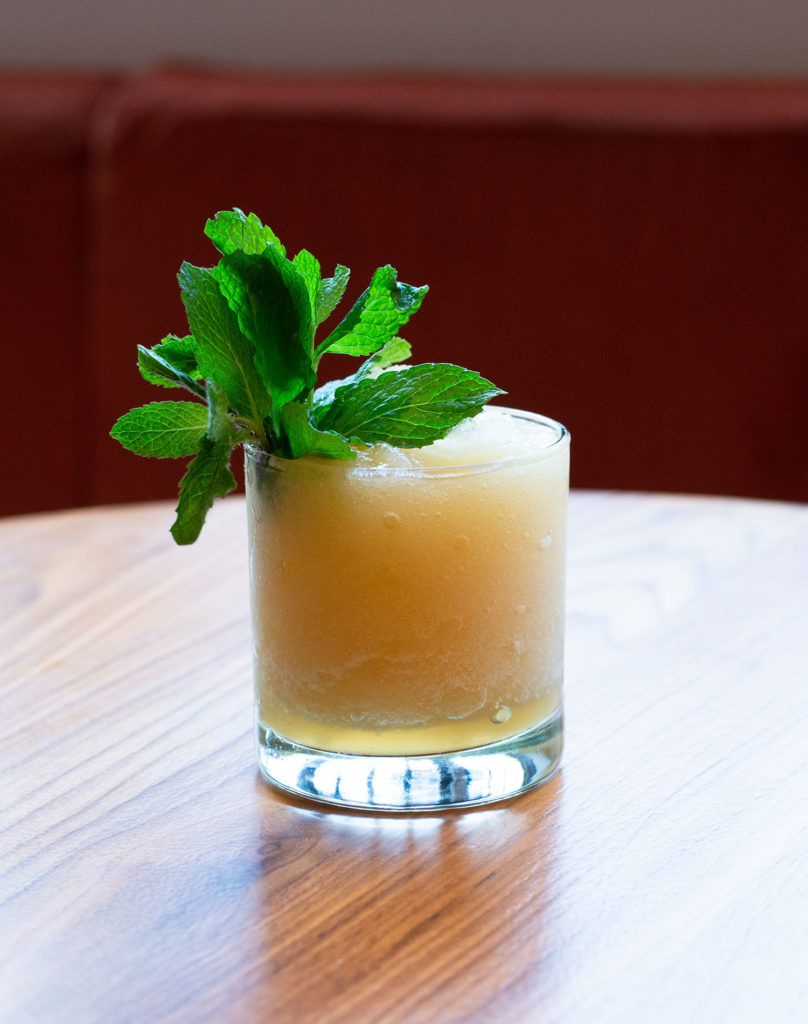
1 oz Appleton Estate 12 Year
¾ oz Don Q Cristal
½ oz El Dorado 12 Year
¼ oz Wray & Nephew Overproof
½ oz Orgeat Works Latitude 29 Falernum
½ oz honey syrup
½ tsp ginger syrup
1 oz orange juice
½ oz lime juice
2 dashes Angostura Bitters
1 oz soda water
Blend everything (including soda) with ice for 5 seconds, then dump unstrained in double rocks glass. Garnish with mint.
Timeless
Ben: Moving back to the Mai Tai, it’s probably the most famous drink from that early tropical drink era, the ’30s and ’40s, and it’s still around. What do you think is the lasting appeal of that particular profile?
Shannon: I think the appeal is the fact that it became really ambiguous after the world drank up Wray and Nephew 17, and there were so many variations, and iterations, and bastardizations, dare I say. And people were on the hunt for where they could get the real Mai Tai. I don’t know how many of you have been to Hawaii, but I know a few people who’d said, “I couldn’t get a Mai Tai there, and I thought I could,” and they were pissed about it. I’ve not had that experience, because I know better than asking for one in Hawaii.
But where the drink’s concerned in my work, I opened Glady’s five years ago, and our initial mission was to showcase Caribbean rums. I have to admit, I was skeptical of tiki at the time, because there weren’t a lot of good examples in New York to draw from, and I didn’t know if there was an audience for it. But, as I looked at the Mai Tai spec—I’m really fond of funky Jamaican rums, and Martinican rums, and things of that nature. I wanted to find a way to make it work on my menu, so that was my exception, and we’ve had it now for four years. For me the challenge is what rums would I use, that were available at the time, to feel faithful to the spec and keep it simple and compelling.
A Mai Tai by Lynnette Marrero, presented by Natasha Bermudez
Ben: We are just about to be served our second drink, which is a collaboration between Natasha and Lynnette Marrero. It’s quite an elegant, restrained Mai Tai. Do you want to tell us about what we’re drinking?
Natasha: Unlike most Mai Tais now, it’s not overproof or so boozy. We are focused on keeping drinks in our program that are going to be approachable for every guest, and that they’re able to enjoy with food. That’s why we try to keep our balance in the lower proof.
We have two dark rums, the Mount Gay Black Barrel and Plantation Xaymaca. Both have a beautiful, bright finish. The Xaymaca brings a lot more fruitiness. You get that awesome pineapple and banana. And then Rhum J.M is just all funk. We kept it to about two ounces.
And “Tiki” Adam’s orgeat. I think it tastes like chocolate, and I love that. It rounds out all the fuller flavors of these rums, and they go nice together. It was really exciting to create this Mai Tai.
I recently worked at Donna Cocktail Club, where I’ve never in my life made so many Mai Tais. Mai Tais and Margaritas. Isn’t a Mai Tai a rum Margarita, anyways?
Ben: Now you’re talking. I definitely want to talk about that. And the so-called island style Mai Tai Shannon mentioned. We’ll get back to that.
Natasha, when we spoke a couple of weeks ago about this, you talked about how when people think tropical drinks, they’re thinking about shaken drinks served over crushed ice, something like what we have tonight. Are there other ways to capture that feeling, without going with that exact profile?
Natasha: Yeah. I was born on an island, and I grew up on an island. The representation of tropical drinks has always been, you’re going to have all these fruits, and they’re going to have all this ice. But guess what? Ice is expensive. So, a lot of these drinks, like Ti’ Punch, don’t even call for ice. I try to approach tropical drinks in a different way. I like to do a lot of stirred drinks, utilizing the different rums, and other South American spirits, still bringing all that fruit, both juices and liqueurs.
There’s always a different way to approach tropical; I like the idea of doing something that’s not expected, I like the element of surprise. I’m thinking, why am I not making a Mai Tai that has, I don’t know, citric acid and rum, and almond liqueur, and just call it a Mai Tai. Why not? I think that would be awesome.
Mai Tai by Lynnette Marrero, presented by Natasha Bermudez
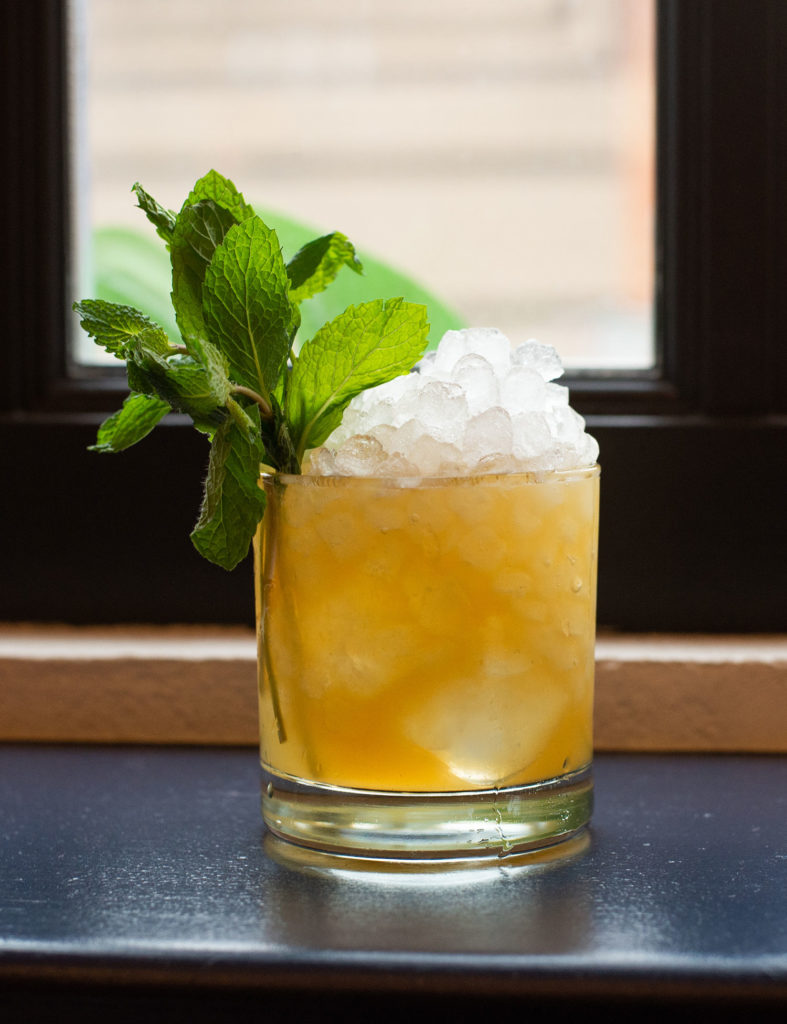
¾ oz Mount Gay Black Barrel
¾ oz Plantation Xaymaca
½ oz Rhum J.M VSOP
½ oz Cointreau
¾ oz Orgeat Works T’Orgeat
1 oz lime juice
Shake with 3 large cubes. Strain into double rocks glass filled with crushed ice. Garnish with mint.
Demarcations
Ben: The kind of drinks that people in the Dominican Republic are drinking, they’re not tiki drinks, but sometimes people put them in the same category. How does that demarcation work for you?
Natasha: I didn’t know what tiki was until I started bartending. A lot of people still don’t know what tiki is. To me it was like, “Oh, so, you mean tropical drinks?” There are still a lot of people who put Daiquiris and Piña Coladas in the tiki category, when they are tropical drinks. Because they were made in the Caribbean, with Caribbean rum. Tiki is this tropical escape that Americans wanted to have, when to us it’s where we live, every day. All right, cool. I get it. My life is an island vacation. I totally get that, but I think there is a more sensitive way to deal with that.
Everybody should do what makes them happy. My boss told me you’re never going to make everybody happy. I’m always conscious that I’m not Peruvian and I’m not Japanese. When I’m making drinks for Llama San, I think about, “How do I represent you without misappropriating you?” That’s a conversation to have. As much as I love tropical drinks, we are talking about people in those countries making the rums—are they getting any benefit out of this so-called tiki culture? So, there’s a lot more to explore there.
Ben: I think one of the big misconceptions is that, if I go to the Caribbean, people back home say, “How are the tiki drinks down there?” They don’t do tiki in the Caribbean. There are zero tiki drinks in the Caribbean.
Natasha: We drink rum. I grew up drinking aged Brugal in a Styrofoam cup with ice and Coca-Cola at the beach. That was my drink. I was eighteen—sixteen—years old, drinking rum at the beach. Out of Styrofoam. I didn’t even know what a Cuba Libre was until I moved to the U.S. I was like, “What do you mean, a Cuba Libre? You mean a rum and coke?”
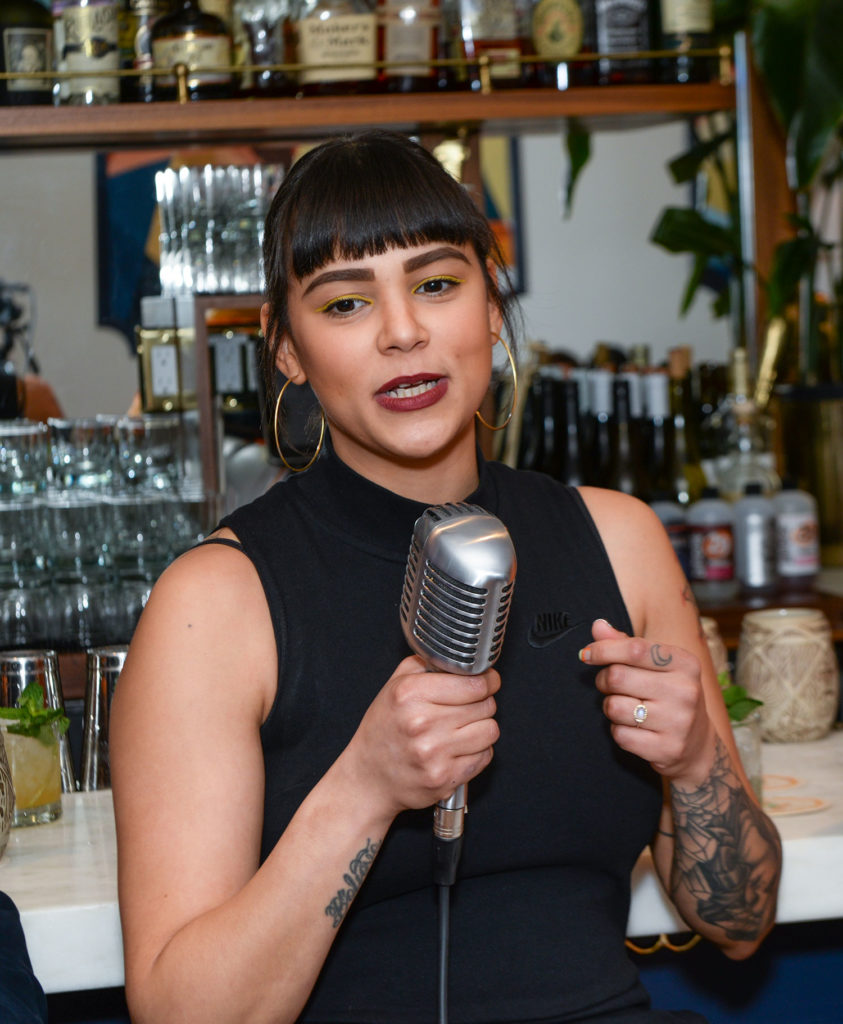
Ben: Shannon, I want to ask you as well, because your book is called Tiki, and it has some really tiki recipes in it, but I think it also draws upon this wider world of tropical drinks. In terms of nomenclature, do you make a different distinction between those than Natasha has?
Shannon: Absolutely, in the sense that the precursor to tiki drinks, as a style or genre, was tropical drinks. And again, this is all retrospective, in terms of how we look at what those cocktails were, and the Beachbum had a big hand in helping us to see through the lens of looking back, so to speak. So, I’ll just put it out there like this. At the Trader Vic’s restaurants, were they calling it tiki? At the Donn Beach bars, were they calling it tiki? They were calling it “exotic.” So, the way we have named it changed over time. I think it’s important to point that out. The way we have looked at it over time has changed, and so we have to be aware of that as we discuss how they differ, how they overlap.
But, in my world, or at least in my book, a tropical cocktail is one that is derived from ingredients and spirits that come from south of the equator, or within twenty degrees of the latitudes. There’s a wide range of interpretations. There’s a canon of tiki drinks that we all reference, but there are also simple builds like a Cuba Libre, or just rum with coconut water, or rum and pineapple juice. Those are foundational flavors. I like to say that “what grows together, goes together.” You start with those basics, and then, in America, we took those basics and added a shroud of mystery, where they’re putting orgeat in various serves, and making it “exotic,” to elevate the experience. You think back to L.A. in the Depression, think about someone who encounters this environment that was cool, with palm trees, and these words you’ve never seen a menu before, that are totally apart from gin and whiskey drinks. It’s not just what’s in the glass, it’s the environment and marketing around it. It’s a mentality.
Garret: I have a fun metaphor to throw in here—Phil Ward and Mayahuel. Phil opened an incredible mezcal cocktail bar, and I think that if we were to study that bar a hundred years later, what people would be confused by is, “So, was he doing Latin drinks?” Well, no. He worked for Julie Reiner at Flatiron and Audrey Saunders at Pegu Club, took a lot of the information that he got there, fell in love with mezcal and agave spirits, went and engaged that community, and studied it. Then he created Mayahuel and made those drinks through his lens of classic cocktails. He wasn’t pretending he was making authentic Latin drinks. His Division Bell is not something where he’s like, “Well, I picked this up in Mexico City.”
I think Don the Beachcomber’s experience, when he traveled, was probably something similar. Unfortunately, that’s a period of his life that we don’t have enough information about, and if anyone would like to fund an investigation into that period of his life, you’d have people who would be very interested. But fusion is an interesting idea that we have to answer for, and tackle, and talk about, and be aware of. Because there’s a lot of consumer misunderstanding over what the division is, as we’ve just discussed.
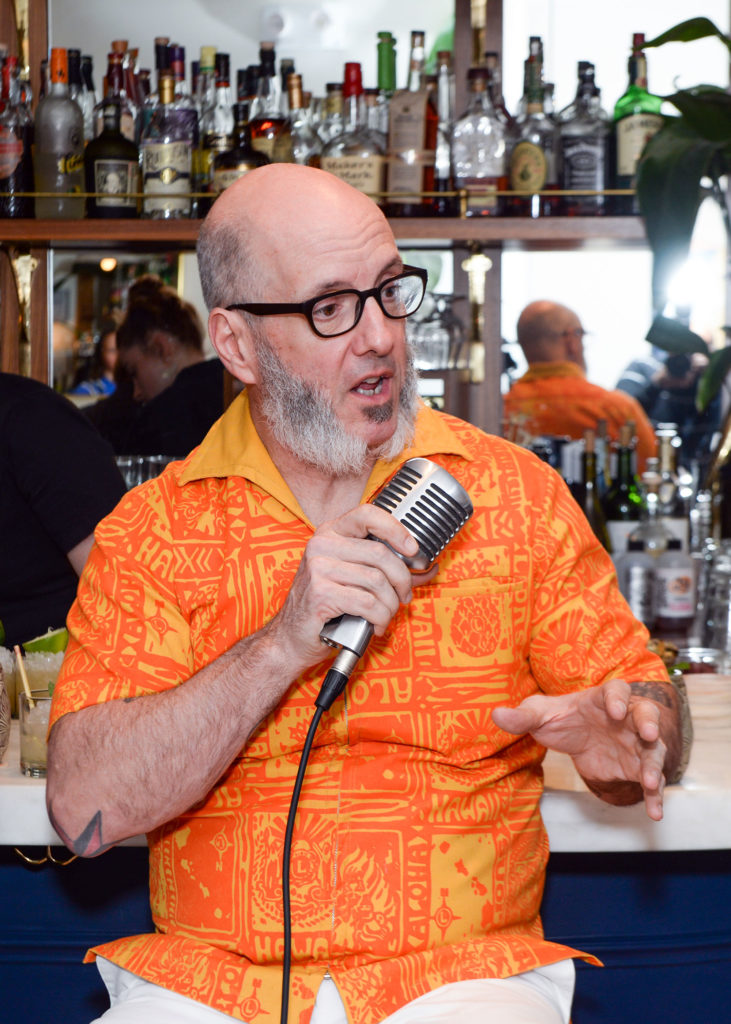
Rums for the Mai Tai
Ben: That original Mai Tai had the Wray and Nephew 17, which has become this Holy Grail Jamaican rum; its source liquid hasn’t been made since at least the 1920s. Even Vic himself ran out of it, and started substituting. In the drinks we’re trying today, we have many different combinations of rums, and obviously the idea is to go for that Mai Tai feeling, whatever that may be. What is the rum profile that you look for when you’re making Mai Tais?
Adam: My Mai Tai is kind of a time capsule, in that the rum blend I derived was through the available ingredients back in 2005. The goal being emulating that Wray and Nephew 17. Back in the day it was Appleton Special, add a bit of agricole, and a bit of El Dorado 12. It’s of the era. We can talk about more sensible contemporary hacks, if you will, to get that profile that we think was the Wray and Nephew 17.
Ben: How do you pick your rum?
Natasha: I like funk.
Shannon: I’d like to say, your honor, I promise to give you the funk. The whole funk. And nothing but the funk.
It was El Dorado for me and Martinican rum off the bat. I was using Duquesne. Over time it evolved to include Hamilton rums. Sometimes Neisson and Batavia Arrack. But it evolved as products evolve. I’ve done Mai Tais with Paranubes and with Hampden. It all depends on what I can get my hands on. I couldn’t get those five years ago.
I’m always looking for a way to reflect, first and foremost, what I believe is the best product available. I’m not going to say I’m recreating the Trader. I just want to give you the best of what I believe the rums are at the time.
Garret: I keep talking about agave. Natasha mentioned the Margarita. To me, a Mai Tai should be as accessible as a Margarita for people. The way I build my Mai Tai is very much taken from the Tommy’s Margarita in shake style. I think funk can be great. People get excited to use new products. But in the philosophy that we have at Exotica, it’s more about trying to recreate that romantic nostalgia that you have for a drink. A Mai Tai should have a ninety-nine percent accessibility. In the same way, if you rolled up to Tommy’s, and you were an average consumer, I don’t think they would give you Tapatio 110. The Mai Tai that I serve at Exotica, off the bat, I’m not going to give you Paranubes or something that’s super aggressive. I want a cohesive product.
Ben: Over the last couple of decades, just about every published or utilized spec was a combination of a Jamaican rum with a Martinican rum. The reason for this was to try to bring some of that power back that Jamaican rums had lost over the last fifty years. Now we’re seeing funky Jamaicans come back. Is it time to rethink that approach? Martinique wasn’t really part of the mix, to begin with. Are there other ways to think about the Mai Tai spec today?
Garret: Yes. Background: why did Martinique happen? Where did that island come from? The seventeen-year-old Wray and Nephew rum disappeared by 1950. Six years of a cocktail becoming a viral sensation wiped out a product. That’s pretty awesome.
But eventually, Trader has to do something. Because now he has a bunch of restaurants, a bunch of locations across the United States. You can’t just take the drink off the menu, right? The show must go on. The first substitution is he gets the lesser-aged Wray and Nephew 15, he cuts it with Coruba, just to get the added body. Then, over time, the fifteen is also wiped out. What is he going to do? Keeps the Coruba in there, but grabs the Martinique rum.
In his writings, Vic says, “When I grabbed the Martinique, I noticed it had a very nutty character to it.” The thing that’s not mentioned is that, most likely, at that time, Martinique AOC Rhum agricole is not coming into the United States. Because the French didn’t think we would like it. They were keeping it for themselves. What we were getting was very thick molasses rums that were used by the French for cooking. They were rhums traditionnels. He paired that with Coruba. That became the replacement Mai Tai. Over time, even that molasses Martinique rum disappeared, and then that’s where Rhum Saint James came into play for the Trader Vic organization.
It was way down the line that agricole came in. Agricole is awesome in a Mai Tai. The Trader Vic Mai Tai became an ounce of Rhum Saint James and an ounce of Appleton 12, and that was the forever Mai Tai until very recently. I think it’s a great showcase for agricole. It just depends on what you’re looking for. You could run a different Mai Tai every month at your place, if your guests wanted that.
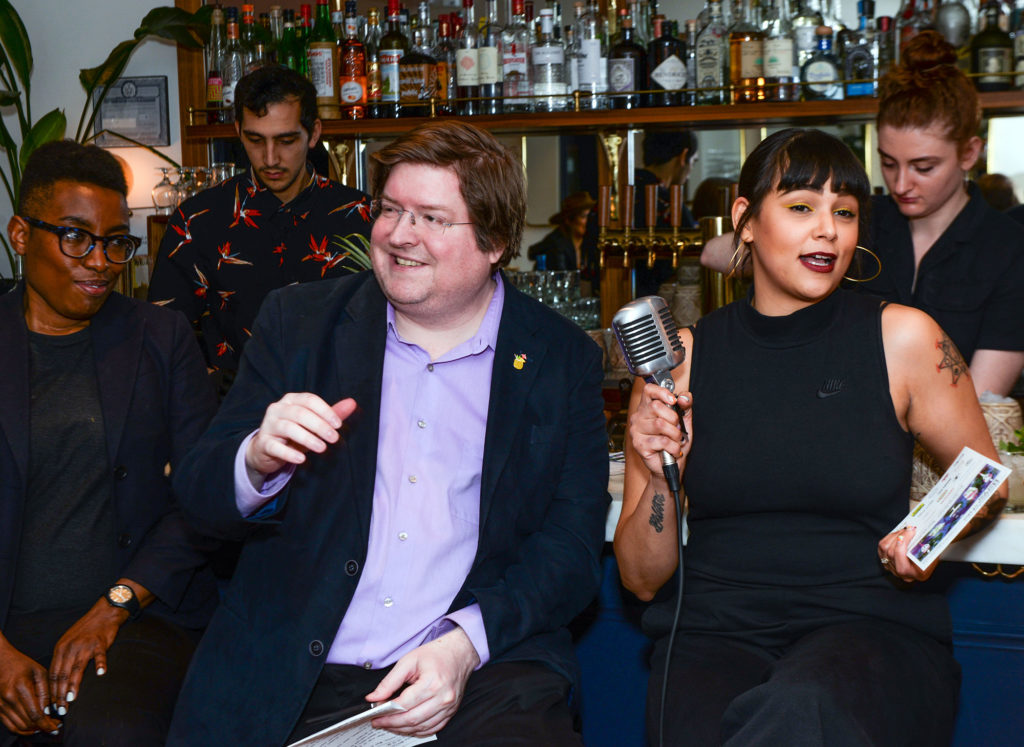
A Mai Tai by Shannon Mustipher
Ben: With that in mind—Shannon, they’re passing around your first drink.
Shannon: Denizen developed this blend with the Mai Tai in mind. They had the idea that you could recreate what the Trader came up with by starting with a heavy pot-still, high-ester Jamaica rum that’s coming out of Worthy Park. Their distillation methods have not changed very much in over a hundred and fifty years There was a little bit of a break in production, but they’re pioneers in funky rums, which I love.
Then adding the Rhum Grande Arôme from Le Galion on Martinique, which has been absent from the American market up until Denizen putting it into this blend. It’s near to my heart not only for its application in this cocktail, but for the fact that there’s no other way to experience a Grande Arôme rum like this, apart from going to Martinique and going to the grocery store, where you’ll find it on the lowest shelf, because they use it for confectionery, for cooking, as Garret said. I smuggled a bottle back. Sometimes we like to glorify labels and brands, but it’s really about the flavors you’re seeking. It doesn’t matter where it came from, in my book.
Ben: You took the Denizen and then added more funk with the Rum Fire.
Shannon: Again, I’m very biased toward Jamaica. Hampden, for the same reason, I just love the tradition behind the distillery. The methods have not changed significantly in over two hundred years. That’s the kind of rum I trust. It has a lot to do with what I want to convey with the rum program at Glady’s. Yes, cocktails are important, but in my program, I need people to see rum in the most positive light. I trust producers that have been doing it well for some time.
Trader’s Treasure by Shannon Mustipher
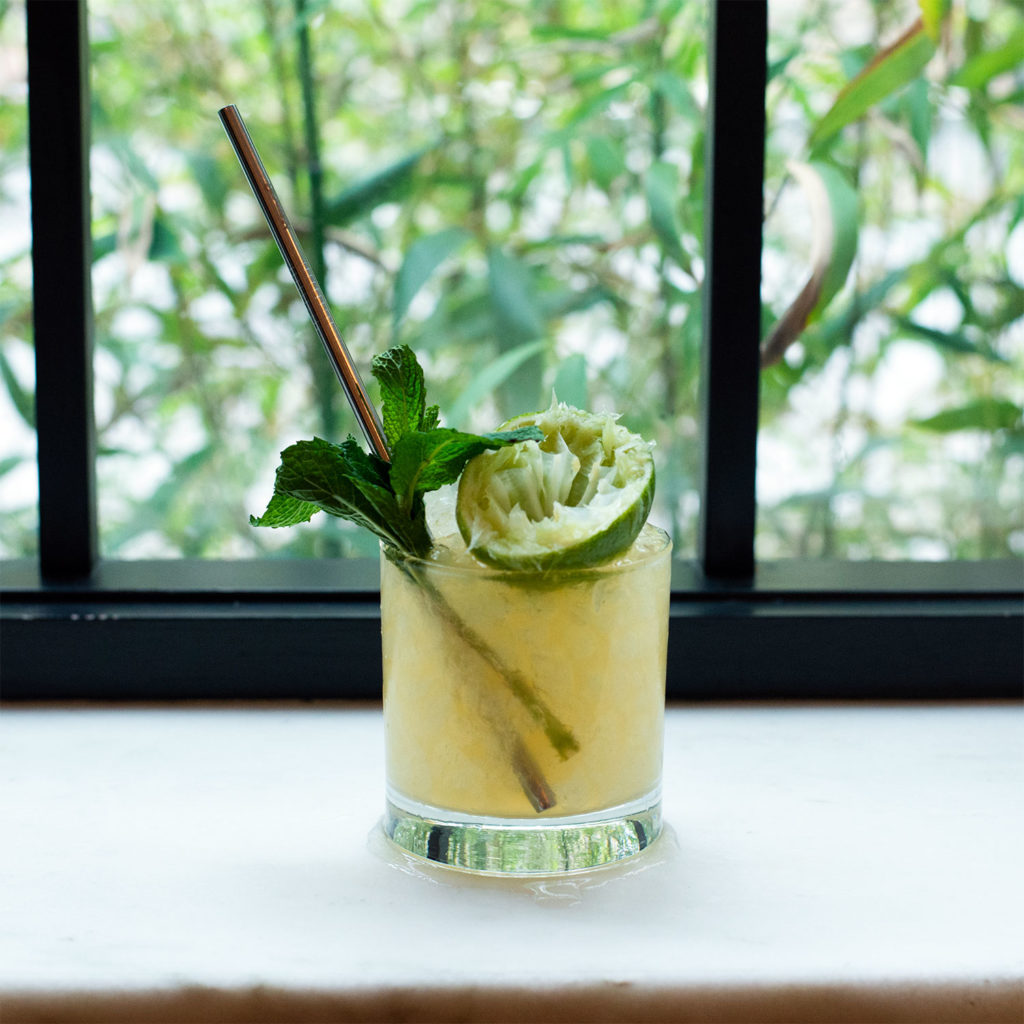
1 ½ oz Denizen Merchant’s Reserve
½ oz Rum Fire
½ oz Giffard Curaçao
½ oz Orgeat Works Heavy Duty Orgeat
¾ oz lime juice
Shake with ice and strain into double rocks glass filled with crushed ice.
